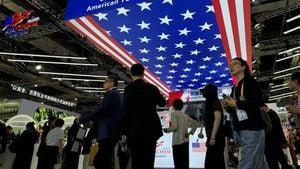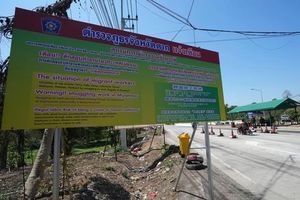Asian stock markets kicked off the week of August 18, 2025, with a burst of optimism, as investors across the continent responded to fresh signs of progress in the ongoing U.S.-Russia dialogue over a potential Ukraine ceasefire. This flicker of hope for peace reverberated through trading floors from Tokyo to Mumbai, with many major indexes notching impressive gains and even historic milestones. The mood, however, was tinged with both geopolitical intrigue and economic uncertainty, as policy decisions and diplomatic maneuvers sent ripples through global markets.
According to Investing.com, the day’s positive sentiment was palpable across most Asian bourses. Japanese shares, in particular, stood out as both the Nikkei 225 and TOPIX indexes climbed 0.8% and 0.5%, respectively—both reaching record highs. The rally was driven by a confluence of factors: robust second-quarter gross domestic product figures released the previous Friday, a weaker yen that gave a leg up to export-oriented sectors, and the Japanese government’s dismissal of rumors that the U.S. was pressuring the Bank of Japan (BOJ) to hike interest rates. This came in the wake of remarks from U.S. Treasury Secretary Scott Bessent, who had said the BOJ was “behind the curve” and needed to raise rates. Despite such external commentary, Japanese officials held firm, and investors responded with enthusiasm.
China and India also enjoyed a surge of investor confidence, each for their own reasons. China’s Shanghai Shenzhen CSI 300 and Shanghai Composite indexes rallied by 1.5% and 1.2%, respectively. The Shanghai Composite soared to a nine-year high, while the CSI 300 reached its loftiest level since October 2024. India’s Nifty 50 index mirrored this upward momentum, jumping 1.5% in morning trade to a three-week high. The underlying driver for both markets was a growing belief that a swift resolution to the Russia-Ukraine conflict could ease U.S. scrutiny of their purchases of Russian oil. For months, both Beijing and New Delhi have faced criticism—and the threat of punitive measures—from Washington over their energy ties with Moscow.
The diplomatic chessboard was in full view as former U.S. President Donald Trump met with Russian President Vladimir Putin on Friday, August 15. Trump flagged what he described as “positive, albeit vague developments” from the meeting, though he stopped short of offering specifics. Eyes quickly turned to his next set of engagements: a planned meeting with Ukrainian President Volodymyr Zelensky on Monday, August 18, and a round of talks with European leaders. In a headline-grabbing statement on Sunday evening, Trump claimed Zelensky could end the war by ceding Crimea to Russia and dropping Ukraine’s bid to join NATO. The suggestion set off a flurry of speculation about the prospects for peace—and the potential costs to Ukraine’s sovereignty.
But the diplomatic maneuvering didn’t stop there. Trump also announced that the U.S. would impose a steep 50% tariff on Indian exports later in August, as punishment for India’s continued purchases of Russian oil. The move, he argued, was necessary because such trade was “funding Russia’s war against Ukraine.” The threat of tariffs loomed large over Indian markets but did little to dampen the day’s bullish mood, as investors wagered that a peace deal might yet avert a full-blown trade spat.
Meanwhile, Hong Kong’s Hang Seng index posted a more modest gain of 0.6%. The market was held back by losses in property and technology stocks, which lagged behind the broader rally. South Korea’s KOSPI index, by contrast, slipped 1.3% after a long weekend, with local tech stocks catching up to losses suffered by their U.S. counterparts late last week. Australia’s ASX 200 was essentially flat, stalling just below record highs achieved the previous week. The index was weighed down by losses in heavyweight mining and energy stocks, which struggled amid a broader selloff in oil shares across the region.
Oil stocks in Asia were particularly hard hit, tracking a global dip in oil prices. The selloff was fueled by growing bets that a Russia-Ukraine peace deal could be imminent, which in turn would likely loosen the geopolitical chokehold on energy markets. Singapore’s Straits Times index, which had touched record highs the week before, shed 0.6% as profit-taking set in.
Amid all the market action, the underlying theme was clear: geopolitics and monetary policy remain deeply intertwined in shaping investor sentiment across Asia. The prospect of a ceasefire in Ukraine—however tentative—offered hope that some of the region’s thorniest trade and energy issues might be resolved. For China and India, in particular, the stakes are high. Both nations have faced mounting pressure from Washington over their imports of Russian oil, and a peace deal could provide much-needed breathing room. As Investing.com noted, “Chinese and Indian markets were boosted by hopes that the U.S. will not disrupt their buying of Russian oil, especially if a peace deal is reached between Moscow and Kyiv.”
Japan’s performance, meanwhile, underscored the country’s resilience in the face of external headwinds. The government’s decision to push back against U.S. calls for higher interest rates was met with approval by investors, especially as the weak yen continued to benefit export-heavy industries. The strong GDP data released on August 15 further reinforced confidence in the Japanese economy, even as trade tariffs and inflation posed ongoing challenges.
Not all markets shared in the exuberance, however. South Korea and Australia both faced headwinds from the technology and resource sectors, respectively. In Korea, the KOSPI’s decline reflected a delayed reaction to U.S. tech stock losses, while Australia’s mining giants struggled to maintain recent momentum. Singapore’s retreat from record highs served as a reminder that profit-taking and sector-specific pressures can quickly temper broader rallies.
Looking ahead, Asian investors will be watching closely for further developments on the diplomatic front. Trump’s meetings with Zelensky and European leaders could set the tone for the next phase of the Russia-Ukraine conflict—and by extension, the global economic outlook. The threat of tariffs, the fate of energy markets, and the possibility of interest rate shifts in major economies all remain in play.
In a region where markets are often at the mercy of distant political decisions, the events of August 18, 2025, offered a glimpse of both the risks and rewards of global interconnectedness. For now, Asian stocks are riding a wave of cautious optimism, buoyed by the hope that peace—and perhaps a little economic relief—might finally be within reach.



